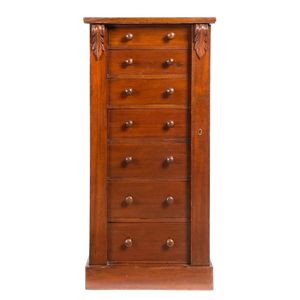19th Century Mahogany Wellington Chest
You must be a subscriber, and be logged in to view price and dealer details.
Subscribe Now to view actual auction price for this item
When you subscribe, you have the option of setting the currency in which to display prices to $Au, $US, $NZ or Stg.
- Corbel - An architectural term for a support for a projecting bracket, ostensibly supporting a beam or horizontal feature, but used in bookcases, sideboards and chests as a decorative element. Corbels are often carved with acanthus or other scrolling decoration.
- Plinth - The square or rectangular base of a piece of cabinet furniture, often ornamented with moulding. The plinth may be separate, as in some wardrobes or presses, and act as the support for the carcase. In a false plinth, the moulded boards may be attached directly to the piece. Furniture with a plinth base usually does not have separate feet. The term derives from architecture where it denotes the base of a column or statue.
- Turning - Any part of a piece of furniture that has been turned and shaped with chisels on a lathe. Turned sections include legs, columns, feet, finials, pedestals, stretchers, spindles etc. There have been many varieties and fashions over the centuries: baluster, melon, barley-sugar, bobbin, cotton-reel, rope-twist, and so on. Split turning implies a turned section that has been cut in half lengthwise and applied to a cabinet front as a false decorative support.
- Mahogany - Mahogany is a dense, close grained red-coloured timber from the West Indies and Central America. It was first imported into Europe in the the early 18th century and its use continued through the 19th century. It was popular for furniture making because of its strength, the wide boards available, the distinctive grain on some boards, termed flame mahogany and the rich warm colour of the timber when it was polished.. The "flame" was produced where a limb grew out from the trunk of the tree, and this timber was usually sliced into veneers for feature panels on doors, backs and cornices.
Some terms used to describe mahogany relate to the country from which it originally came, such as "Cuban" mahogany, "Honduras" mahogany etc. However unless the wood has been tested the names assigned are more a selling feature, rather than a true indication of the timber's origin.
This item has been included into following indexes:
- chests of drawers, period - Victorian 1,216
-
chests of drawers, style
- seven drawer 138
- Wellington 67
Visually similar items

A Victorian cedar secretaire Wellington chest. Later 19th century, the chest with six drawers of differing depths, one with a faux front serving as a fold down writing plane and concealing two half width drawers and four pigeon holes, with acanthus carved

A Victorian mahogany miniature Wellington chest, seven drawers, turned wood knobs, on plinth base, drawers all locked in place by a hinged panel to both sides, one panel with lock and key. 37.5 x 26 x 51 cm

An English mahogany Wellington chest, 19th century. 101 cm high, 48 cm wide, 34 cm deep

A George III mahogany chest on chest, with moulded cornice, with carved dentil moulding, above two short graduated drawers, the lower section with three graduated drawers on bracket feet. 188 cm high, 109 cm wide, 61 cm deep
